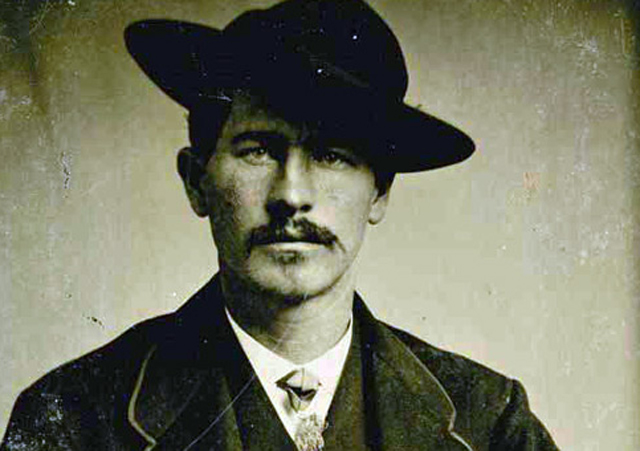
In my last article for this series, I highlighted Queen Elizabeth I, a real historical figure that has enjoyed many varied depictions on the big screen. In this article, I chose to highlight yet another subject from history, but from a decidedly different era altogether. The American West has given the world many fascinating figures of legend , whether real, fictional, or a combination of both. Larger than life characters like Jesse James, Calamity Jane, Billy the Kid, and “Buffalo” Bill Cody have all achieved immortality within folklore and later through cinematic adaptation. But if there was one that stood out as the most prolific, it would be legendary U.S. Marshall Wyatt Earp. Born in 1848, Earp worked all across the American frontier, but once he arrived in the town of Dodge City, Kansas, he fell into the role that would eventually define him; that of a lawman. After a semi-successful career in Dodge City (where he would meet one of his most trusted associates, John “Doc” Holliday), Earp took up the head U.S. Marshall position at a boomtown in the Arizona Territory called Tombstone, and it was here that he would become a legend. The moment that defined his life and career came on October 26, 1881, when Earp, Holliday, and two of Earp’s brothers faced down the Clanton gang at the Tombstone O.K. Corral, which led to the most famous gunfight in U.S. history. In the end, the cowboy gang was slaughtered and Earp’s posse was triumphant. The incident became the basis for so many Western legends since. Naturally, Wyatt Earp makes for an ideal Western hero, and Hollywood has revisited his story many times on the big screen. In this article, I will take a look at how that legendary image translated to cinema and endured over the years as the genre itself had changed.
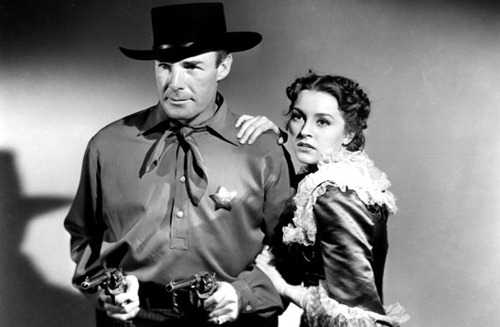
RANDOLPH SCOTT in FRONTIER MARSHALL (1939)
Wyatt Earp’s standoff at the O.K. Corral had been recreated many times over in the silent era of film, but in the era of talkies, Hollywood didn’t get around to adapting his story until this feature. In the role of Earp, the filmmakers cast rising star Randolph Scott, an actor who would come to define the Western genre in the years since. Though Scott plays the role of a frontier lawman well enough, the problem is that the character he depicts in the movie shares nothing with the real Wyatt Earp other than just his name. The movie Frontier Marshall doesn’t portray the story of Wyatt Earp so much as it appropriates it into the formulaic Western narrative that it wanted to tell. Here, Earp is as interchangeable as any other Western hero from that time period. The film even rewrites the famous O.K. corral scene, portraying it as a lone standoff between Earp and the outlaw cowboys. Doc Holliday (portrayed here by Cesar Romero) is not present in that moment like he was in real life; something that would be rectified in future adaptations. Despite Hollywood playing loosely with the real life facts behind the story, Scott still leaves a serviceable impression as the legendary lawman. In the role, you can see the makings of the genre icon that he would eventually become. Because of that, you can excuse the fact that he also doesn’t look much like the real Earp as well, missing the trademark mustache. Eventually, though, Hollywood would recognize that the real life Gunfight was due for an accurate portrayal.

HENRY FONDA in MY DARLING CLEMENTINE (1946)
As the Western genre matured, so did the attempts to adapt the life of Wyatt Earp as well. Fun fact: Wyatt Earp lived long enough to see the early cinematic adaptations of his legendary gunfight being filmed, and on one occasion, Earp visited a set where a young director by the name of John Ford was working. Many years after that encounter, Ford would bring the story of Wyatt Earp to the big-screen in what many consider to be one of the greatest Westerns ever made. For one thing, the casting of Henry Fonda couldn’t be more perfect. The dashing leading man gives the role a dignified air, and while at times he can be a bit too stoic in the role, Fonda nevertheless delivers on making Earp a beloved hero worth rooting for. They also got the look right, with Fonda sporting the trademark mustache for the role. The gunfight in particular is perfectly staged; intense and suspenseful. The buildup to the climatic moment is what really makes it a standout, building quietly without music and minimal dialogue. It’s a mastery of direction that you would only find from the genre’s definitive director, John Ford. In addition, the movie also finds time for the other members of Earp’s posse, with Victor Mature lending great support as Doc Holliday as well as from Ward Bond and Tim Holt as the Earp brothers. But make no mistake, it’s Fonda that really carries this movie, making Wyatt Earp the idealized lawman; pure in his intentions and steadfast in his resolve. The image of Earp sitting on the front porch of his office, with one leg raised up against a pillar as he looks down the street has since become one of the most iconic images of the Western genre, and it’s a moment that only a great artist like Ford could pull off.
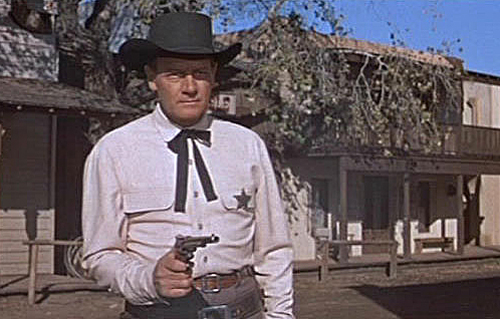
JOEL MCCREA in WICHITA (1955)
When the genre entered the 1950’s, the Western became a perfect showcase for the new widescreen process. Naturally, with the wider canvas, Hollywood wanted to show off the Western frontier in a big way and they drew once again from some of the most legendary stories in the genre. Wyatt Earp was once again chosen as an ideal subject for this new era of Westerns, but Wichita did something very different with the character, and that was to portray the early years of the man’s life instead of the most defining ones in Tombstone. In this film, we are introduced to Earp during his time as a cattle rustler in Kansas. As the film shows, the young Earp runs afoul of bandits and other outlaw cowboys making life hard for the people of Wichita, and through these encounters, it leads him down the road to becoming a marshal of law in the small town. It’s an interesting look into Earp’s early years, seeing the events that would eventually lead him down the road to the man he would become. Unfortunately the movie also has the disadvantage of not being too historically accurate. It was in Dodge City that Earp finally became marshal; not Wichita, where he was only a deputy. Also, Earp was in his mid twenties during his time in Wichita, so casting middle-aged Joel McCrea in the role seems a little off. Despite this, McCrea is perfectly serviceable in the role, giving Earp a rugged sternness that works well enough. The widescreen panoramas are also beautiful to look at, capturing the beauty of the American Prairie wonderfully. Overall, this movie does offer up an interestingly different side to the legend of Wyatt Earp, showing his beginnings rather than just relying on showing us his most famous moment yet again.
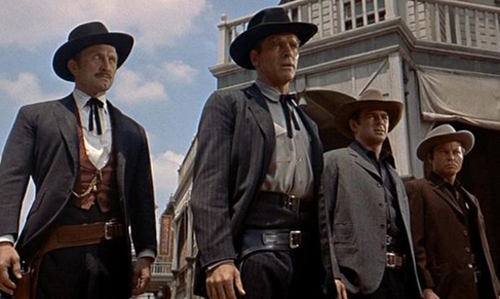
BURT LANCASTER in GUNFIGHT AT THE O.K. CORRAL (1957)
A couple years later, the legendary gunfight would also be revisited on the big screen, only this time, portrayed with a more gritty tone. The interesting thing about this version of the story is that it gives equal attention to both Wyatt Earp and Doc Holliday. The moving stars longtime friends Burt Lancaster and Kirk Douglas as Earp and Holliday respectfully, and it’s easy to see their comraddery translate perfectly into this film. Lancaster makes a natural choice for Earp, though they interestingly left the mustache off this time. He gives the character a nice hard edge, making him both trustworthy, but also intimidating at the same time. But, Kirk Douglas steals the spotlight here as the slick Holliday, and their conflicts on screen generate the best moments on screen. The climatic titular battle is also legendary, supposedly shot over a full week just for six minutes of screen-time. Director John Sturges illustrated his skill as a filmmaker with his spectacular recreation of this scene. You feel the power of ever gunshot as a viewer and for the first time ever, you see the carnage of the event portrayed without diluting the impact. Physically imposing Lancaster would stand for many years after as the standard for the character, maybe not so much in physicality, but certainly in terms of personality. Earp would in the years ahead move away from the purer image seen in My Darling Clementine, and instead become the more tough as nails version that Lancaster portrayed him to be, and that would indeed be a good thing considering how the Western genre changed over time.
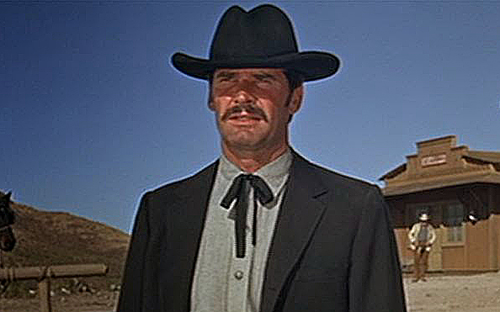
JAMES GARNER in HOUR OF THE GUN (1967)
Years after Gunfight at the O.K. Corral, John Sturges once again returned to Wyatt Earp as a subject, only this time from a different angle. Instead of rehashing the legendary gunfight again, Sturges chose to show what happened afterwards; portraying the later years of Earp’s life as he deals with the consequences of his actions. This makes an interesting companion piece with Wichita, as that movie showed the origins of a legend, this movie likewise shows his deconstruction in the years after the moment that would define his life. Hour of the Gun came at a time when the Western genre was going through a big change, as the genre was less interested in glamorizing the violence of the old West and instead was looking more introspectively into the grim realities of Western life. In this movie, Earp’s triumphant shootout is shown to be just the beginning of a continuing nightmare, as retribution comes back and Earp must face the reality that his duty as lawman puts a bulls-eye on him at all times. The film shows him cleaning up the remaining Clanton gang with his friend Holliday (portrayed here by Jason Robards), and the hunt proves to be even more perilous than the shootout he faced before. Replacing Lancaster as Earp this time was TV’s Maverick himself, James Garner. Garner gives the character of Wyatt Earp a nice vulnerability that you rarely see in other versions. Here, Earp questions his abilities and yet never loses his resolve to serve the law, and it makes for a nice rounded portrayal. And thankfully the mustache makes a return here. It’s a nice look into how a person deals with the consequences of accomplishing a legendary act and how that may be harder than anyone might expect.
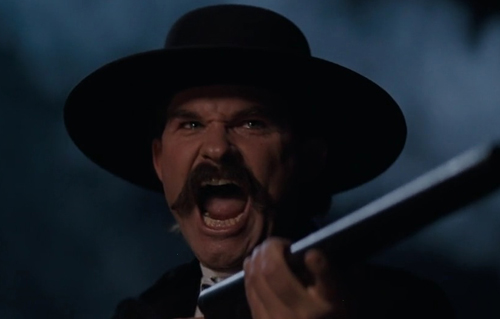
KURT RUSSELL in TOMBSTONE (1993)
As Hollywood moved into the blockbuster era, the Western genre would also leave the gritty and introspective mood of the 60’s and 70’s, once again returning to the over-the-top spectacle that it once was. Wyatt Earp’s story would be given such a treatment in this classic retelling that has since become a beloved hit among Western fans. Let’s be clear, Tombstone is not a subtle movie by any means. Anyone looking for a true to life portrayal of the events surrounding the legendary gunfight should look elsewhere. Still, this larger than life approach is exactly what makes this movie so good. Kurt Russell portrays the legendary Marshall, and it is by far my favorite version of this character. Russell manages to balance the two sides of Earp perfectly; the charming, straight-narrowed man of the law as well as the ruthless, sometimes unhinged gunfighter. Russell gives Earp a ferociousness little seen in other versions of the character, and that makes this portrayal especially great to watch. I especially love the scene where Earp’s posse is ambushed at a watering hole, and Earp begins to lose his mind and take on the entire team of outlaws himself. This moment in particular also has what is perhaps the greatest utterance of the word “NO” ever put on screen. Russell isn’t the only great thing in the movie though, and in fact, his Earp is actually somewhat underdeveloped in relation to other characters. The spotlight in the movie actually belongs to the scene stealing Val Kilmer as Doc Holliday, making it the best version of that character we’ve ever seen. Bill Paxton and Sam Elliot are also solid as Earp’s brothers, as is Stephen Lang as the leader of the Clanton gang. Few other re-tellings of the legendary gunfight have as much cinematic fun with the events as this one does, and though it may be over-the-top, it’s done in a way that actually elevates the legend rather than deter from it.

KEVIN COSTNER in WYATT EARP (1994)
The year following Tombstone, we received another movie about the legendary lawman, this time from Director Lawrence Kasdan and star Kevin Costner. While most films about Wyatt Earp kept focus on the famous O.K. Corral gunfight and it’s participants, this movie chooses instead to tell the full breadth of Earp’s life, from his early days in Kansas to his final days in California. It’s an ambitious film, clocking in a little over 3 hours, and it does a noble attempt of trying to give Earp’s life an epic overview. Unfortunately, such a broad canvas also makes this film feel unfocused and a little stale at times. There’s a reason why previous films focused on just certain events in Earp’s life, because they were the moments that revealed the most about who Wyatt Earp really was. Portraying the full scope of the man’s life and career only diminishes these moments because they become only parts of the whole, rather than the standouts. Still, the movie is not bad and Costner does alright as Earp, even if it is kind of one-note. What I do praise, however, is the portrayal of the legendary gunfight. This film presents what is probably the most historically accurate portrayal of this moment. In reality, the gunfight lasted only 30 seconds, according to eyewitnesses. Wyatt Earp recreates that precisely, showing the shootout as the ugly, quick-bursting killing spree that it probably was in real life; not glamorizing the moment one bit; instead showing the brutality of it. For that attention to detail, I do commend the movie for at least seeking to be true to history. Still, we’ve seen better in the Western genre from both Kasdan (Silverado) and Costner (Dances With Wolves, Open Range), and Wyatt Earp stands as a very flawed, but noble take on the legend. It may have hit a note a little harder had Tombstone not outshone it a year before, but that’s how we judge movies in the Western genre in general. The legends tend to be more fun to watch than the real history.
It’s clear that Wyatt Earp has been a resilient figure in the Western genre over the years, and whether or not the movies represent a historically accurate portrait of the man, it’s nevertheless clear that he’s left an impact. You can see the influence of Wyatt Earp in every heroic fictional Western lawman from Gary Cooper’s Marshall Kane in High Noon (1952) to Adam Cartwright in TV’s Bonanza. The legendary O.K. Corral gunfight has also become the inspiration for pretty much every shootout ever portrayed in cinema, even in the revisionist Spaghetti Westerns. But, it all shows how one moment of destiny can turn any ordinary individual into a legend for all time. Wyatt Earp may not have been the greatest lawman the West has ever known, but his story (embellished or not) has over time become the quintessential representation of everything that we love about the Westerns. I think that when Wyatt Earp’s story is presented in it’s most idealized form, like with My Darling Clementine and Tombstone, it makes for the best Western. Even still, Wyatt Earp, Gunfight at the O.K. Corral and Hour of the Gun also do a serviceable job of building on the legend as well. Whether or not the real Wyatt Earp was like his cinematic portrayals is beside the point now. Just like with how we look at the Founding Fathers of our country, we focus more on the legacy that men like Wyatt Earp leave behind, rather than taking a hard look at the person that they really were. The Western genre is built around idealized heroes and Earp fit that image perfectly. Had he not come out of that pivotal gunfight unscathed, Westerns today would look very different.